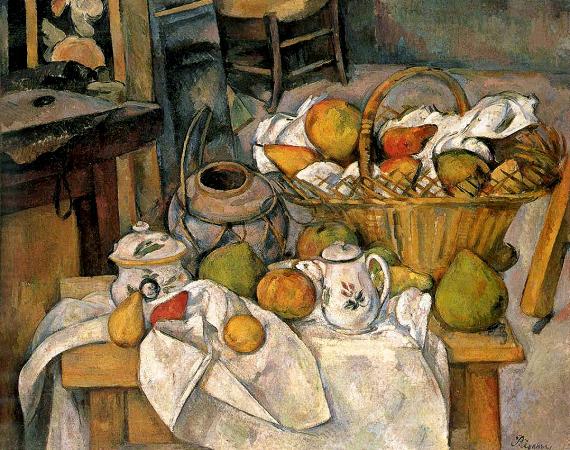Kitchen Still Life. A kitchen is a room or part of a room used for cooking and food preparation in a dwelling or in a commercial establishment. A modern middle-class residential kitchen is typically equipped with a stove, a sink with hot and cold running water, a refrigerator, and worktops and kitchen cabinets arranged according to a modular design. Many households have a microwave oven, a dishwasher, and other electric appliances. The main functions of a kitchen are to store, prepare and cook food. The room or area may also be used for dining, entertaining and laundry. The design and construction of kitchens is a huge market all over the world. Commercial kitchens are found in restaurants, cafeterias, hotels, hospitals, educational and workplace facilities, army barracks, and similar establishments. These kitchens are generally larger and equipped with bigger and more heavy-duty equipment than a residential kitchen. For example, a large restaurant may have a huge walk-in refrigerator and a large commercial dishwasher machine. In some instances commercial kitchen equipment such as commercial sinks are used in household settings as it offers ease of use for food preparation and high durability. In developed countries, commercial kitchens are generally subject to public health laws. They are inspected periodically by public-health officials, and forced to close if they do not meet hygienic requirements mandated by law. The evolution of the kitchen is linked to the invention of the cooking range or stove and the development of water infrastructure capable of supplying running water to private homes. Food was cooked over an open fire. Technical advances in heating food in the 18th and 19th centuries changed the architecture of the kitchen. Before the advent of modern pipes, water was brought from an outdoor source such as wells, pumps or springs. The houses in Ancient Greece were commonly of the atrium-type: the rooms were arranged around a central courtyard for women. In many such homes, a covered but otherwise open patio served as the kitchen. Homes of the wealthy had the kitchen as a separate room, usually next to a bathroom, both rooms being accessible from the court. In such houses, there was often a separate small storage room in the back of the kitchen used for storing food and kitchen utensils. In the Roman Empire, common folk in cities often had no kitchen of their own; they did their cooking in large public kitchens. Some had small mobile bronze stoves, on which a fire could be lit for cooking. Wealthy Romans had relatively well-equipped kitchens. In a Roman villa, the kitchen was typically integrated into the main building as a separate room, set apart for practical reasons of smoke and sociological reasons of the kitchen being operated by slaves. The fireplace was typically on the floor, placed at a wall, sometimes raised a little bit, such that one had to kneel to cook. There were no chimneys. Early medieval European longhouses had an open fire under the highest point of the building. The kitchen area was between the entrance and the fireplace. In wealthy homes there was typically more than one kitchen. In some homes there were upwards of three kitchens. The kitchens were divided based on the types of food prepared in them. In place of a chimney, these early buildings had a hole in the roof through which some of the smoke could escape. Besides cooking, the fire also served as a source of heat and light to the single-room building. A similar design can be found in the Iroquois longhouses of North America. In the larger homesteads of European nobles, the kitchen was sometimes in a separate sunken floor building to keep the main building, which served social and official purposes, free from indoor smoke. The first known stoves in Japan date from about the same time. The earliest findings are from the Kofun period. These stoves, called kamado, were typically made of clay and mortar; they were fired with wood or charcoal through a hole in the front and had a hole in the top, into which a pot could be hanged by its rim. This type of stove remained in use for centuries to come, with only minor modifications. Like in Europe, the wealthier homes had a separate building which served for cooking. A kind of open fire pit fired with charcoal, called irori, remained in use as the secondary stove in most homes until the Edo period. A kamado was used to cook the staple food, for instance rice, while irori served both to cook side dishes and as a heat source. The kitchen remained largely unaffected by architectural advances throughout the Middle Ages; open fire remained the only method of heating food.
more...











